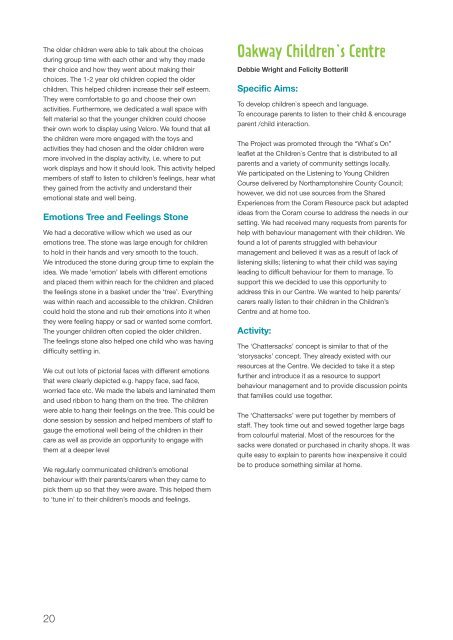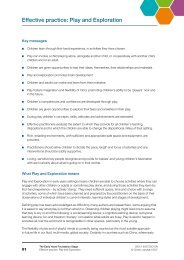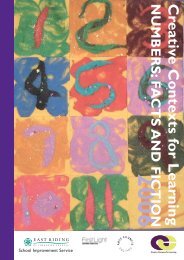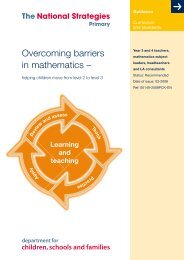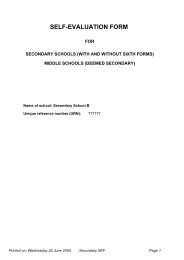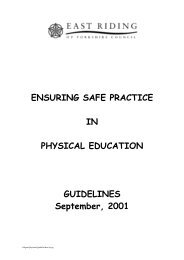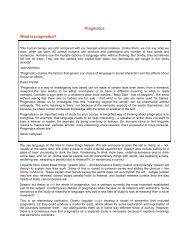Listening to Young Children - Northamptonshire County Council
Listening to Young Children - Northamptonshire County Council
Listening to Young Children - Northamptonshire County Council
Create successful ePaper yourself
Turn your PDF publications into a flip-book with our unique Google optimized e-Paper software.
The older children were able <strong>to</strong> talk about the choices<br />
during group time with each other and why they made<br />
their choice and how they went about making their<br />
choices. The 1-2 year old children copied the older<br />
children. This helped children increase their self esteem.<br />
They were comfortable <strong>to</strong> go and choose their own<br />
activities. Furthermore, we dedicated a wall space with<br />
felt material so that the younger children could choose<br />
their own work <strong>to</strong> display using Velcro. We found that all<br />
the children were more engaged with the <strong>to</strong>ys and<br />
activities they had chosen and the older children were<br />
more involved in the display activity, i.e. where <strong>to</strong> put<br />
work displays and how it should look. This activity helped<br />
members of staff <strong>to</strong> listen <strong>to</strong> children’s feelings, hear what<br />
they gained from the activity and understand their<br />
emotional state and well being.<br />
Emotions Tree and Feelings S<strong>to</strong>ne<br />
We had a decorative willow which we used as our<br />
emotions tree. The s<strong>to</strong>ne was large enough for children<br />
<strong>to</strong> hold in their hands and very smooth <strong>to</strong> the <strong>to</strong>uch.<br />
We introduced the s<strong>to</strong>ne during group time <strong>to</strong> explain the<br />
idea. We made ‘emotion’ labels with different emotions<br />
and placed them within reach for the children and placed<br />
the feelings s<strong>to</strong>ne in a basket under the ‘tree’. Everything<br />
was within reach and accessible <strong>to</strong> the children. <strong>Children</strong><br />
could hold the s<strong>to</strong>ne and rub their emotions in<strong>to</strong> it when<br />
they were feeling happy or sad or wanted some comfort.<br />
The younger children often copied the older children.<br />
The feelings s<strong>to</strong>ne also helped one child who was having<br />
difficulty settling in.<br />
We cut out lots of pic<strong>to</strong>rial faces with different emotions<br />
that were clearly depicted e.g. happy face, sad face,<br />
worried face etc. We made the labels and laminated them<br />
and used ribbon <strong>to</strong> hang them on the tree. The children<br />
were able <strong>to</strong> hang their feelings on the tree. This could be<br />
done session by session and helped members of staff <strong>to</strong><br />
gauge the emotional well being of the children in their<br />
care as well as provide an opportunity <strong>to</strong> engage with<br />
them at a deeper level<br />
We regularly communicated children’s emotional<br />
behaviour with their parents/carers when they came <strong>to</strong><br />
pick them up so that they were aware. This helped them<br />
<strong>to</strong> ‘tune in’ <strong>to</strong> their children’s moods and feelings.<br />
Oakway <strong>Children</strong>`s Centre<br />
Debbie Wright and Felicity Botterill<br />
Specific Aims:<br />
To develop children`s speech and language.<br />
To encourage parents <strong>to</strong> listen <strong>to</strong> their child & encourage<br />
parent /child interaction.<br />
The Project was promoted through the “What`s On”<br />
leaflet at the <strong>Children</strong>`s Centre that is distributed <strong>to</strong> all<br />
parents and a variety of community settings locally.<br />
We participated on the <strong>Listening</strong> <strong>to</strong> <strong>Young</strong> <strong>Children</strong><br />
Course delivered by Northamp<strong>to</strong>nshire <strong>County</strong> <strong>Council</strong>;<br />
however, we did not use sources from the Shared<br />
Experiences from the Coram Resource pack but adapted<br />
ideas from the Coram course <strong>to</strong> address the needs in our<br />
setting. We had received many requests from parents for<br />
help with behaviour management with their children. We<br />
found a lot of parents struggled with behaviour<br />
management and believed it was as a result of lack of<br />
listening skills; listening <strong>to</strong> what their child was saying<br />
leading <strong>to</strong> difficult behaviour for them <strong>to</strong> manage. To<br />
support this we decided <strong>to</strong> use this opportunity <strong>to</strong><br />
address this in our Centre. We wanted <strong>to</strong> help parents/<br />
carers really listen <strong>to</strong> their children in the <strong>Children</strong>’s<br />
Centre and at home <strong>to</strong>o.<br />
Activity:<br />
The ‘Chattersacks’ concept is similar <strong>to</strong> that of the<br />
‘s<strong>to</strong>rysacks’ concept. They already existed with our<br />
resources at the Centre. We decided <strong>to</strong> take it a step<br />
further and introduce it as a resource <strong>to</strong> support<br />
behaviour management and <strong>to</strong> provide discussion points<br />
that families could use <strong>to</strong>gether.<br />
The ‘Chattersacks’ were put <strong>to</strong>gether by members of<br />
staff. They <strong>to</strong>ok time out and sewed <strong>to</strong>gether large bags<br />
from colourful material. Most of the resources for the<br />
sacks were donated or purchased in charity shops. It was<br />
quite easy <strong>to</strong> explain <strong>to</strong> parents how inexpensive it could<br />
be <strong>to</strong> produce something similar at home.<br />
20


